Want to give your space that tropical feel? The White Bird of Paradise is an easy-to-care-for plant that can bring warmth and vibrance to your garden. It has white flowers resembling birds and big leaves, giving your home a South African vibe.
I’ll show you how to give your White Bird of Paradise the best spot, the right amount of water, and how to keep it healthy and pest-free. You’ll also learn about how much sunlight it needs, why it needs soil that drains, and what pests can be harmful to it.
Just me as I discuss how you can get your White Birds of Paradise to grow and thrive in your garden.
- Related article: Explore Bird of Paradise Varieties
6 Key Takeaways on White Bird of Paradise
- The White Bird of Paradise comes from South Africa and has flowers that look like birds and big, banana-like leaves.
- It needs lots of sunlight and soil that drains well to grow well and avoid root problems.
- Water it regularly and sometimes give it fertilizer when it’s growing a lot to keep it healthy and its leaves bright.
- Check for bugs like spider mites and aphids every so often, even though it’s easy to care for.
- Keep it away from pets and kids because it can be poisonous.
- The White Bird of Paradise makes indoor and outdoor places feel tropical and elegant with its lush leaves.
What Is the White Bird of Paradise?
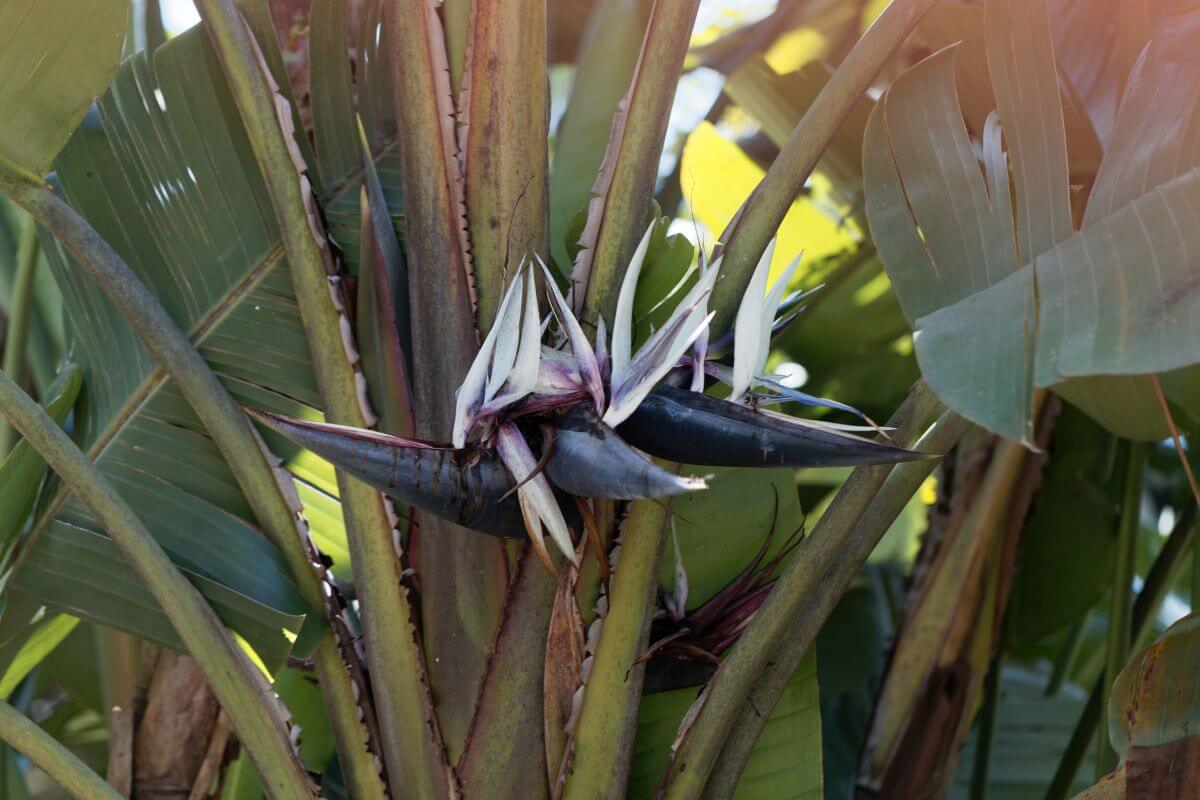
| Scientific Name | Height | Description | Special Qualities | Symbolism |
|---|---|---|---|---|
| Strelitzia nicolai | Up to 30 ft | Large tropical plant with creamy white petals and dark blue flowers | Resistant to pests and droughts, thrives in full sunlight, can grow indoors | Represents faithfulness, paradise, and nature’s beauty |
The White Bird of Paradise (Strelitzia nicolai) is a beautiful plant from the banana family that originates from South Africa. It’s a large tropical plant that can grow up to 30 feet tall, making it a standout in any garden or yard.
One of its best features is its lovely flowers that have creamy white petals and a dark blue section that creates a dramatic look. The plant’s big, shiny leaves that resemble a banana plant add to its tropical appeal.
The White Bird of Paradise is resistant to both pests and droughts, making it easier to care for and maintain. It thrives in the full sunlight of an outdoor environment but it can also be grown well indoors with the right care and light.
In some South African cultures, this plant represents faithfulness, paradise, and nature’s beauty. Its long blooming season and ability to thrive in coastal regions make it popular with most plant lovers.
White Bird of Paradise Care Guide

If you want to grow the White Bird of Paradise inside or outside, I’ve got you covered. This pretty plant just needs the right plant care to stay healthy.
Give it lots of direct sunlight, water it regularly, and keep the humidity right. This guide has easy tips to help you take care of this beautiful tropical plant at home.
Soil Requirements for the White Bird of Paradise
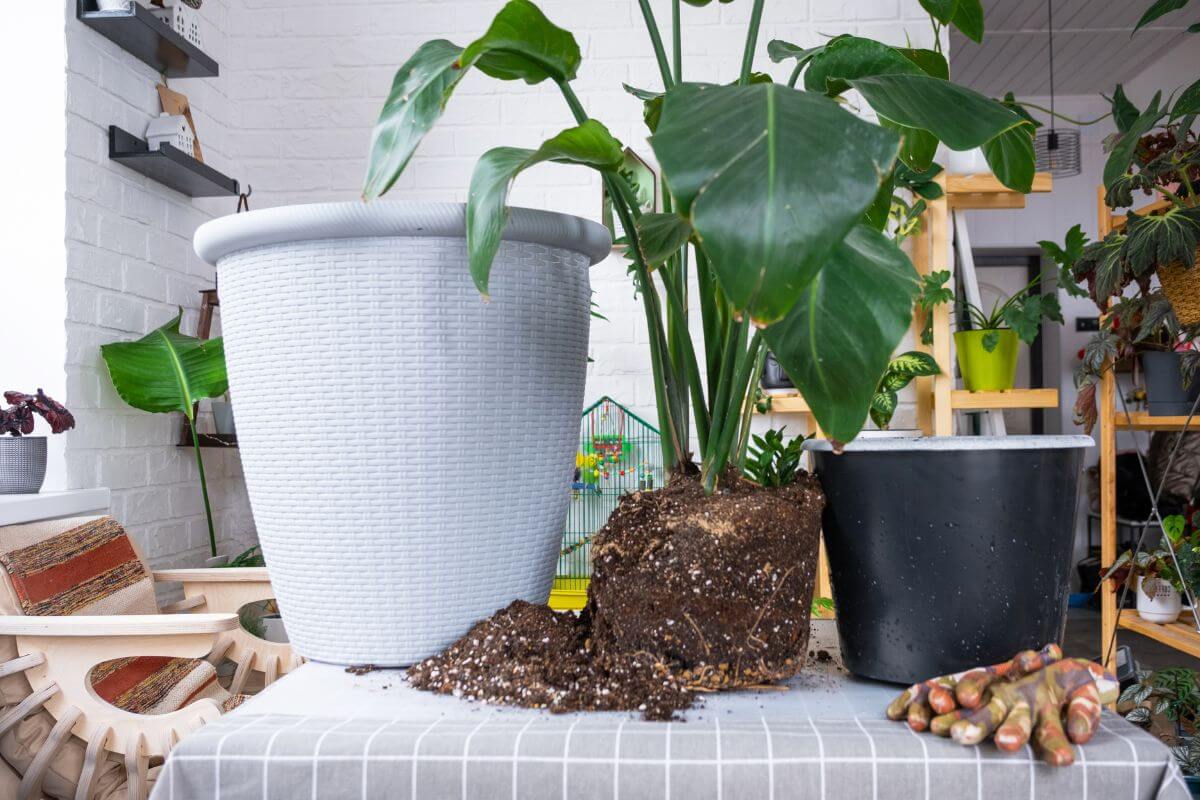
Use soil that drains well for your White Bird of Paradise. Make a good mix by combining equal parts peat moss, perlite, and pine bark in a pot. This mix prevents the soil from getting too wet, which can harm the roots.
I recommend you put a layer of pebbles and gravel at the bottom of the pot before adding the soil mix. Place the pot on a tray of water to keep the soil moist during the growing season. But don’t let the pot sit in water too long because it can damage the roots.
Make sure to also check the soil often and water when the top inch feels dry. Your White Bird of Paradise will bloom beautifully with proper drainage.
Fertilizer for the White Bird of Paradise
Use the right fertilizer to help your White Bird of Paradise grow well and bloom beautifully. Use a balanced fertilizer, like 10-10-10 or 12-12-12. Do this during spring and summer when the plants are growing fast.
Make sure that you follow the instructions on the fertilizer package, usually every 6 to 8 weeks. You can also use a weaker liquid fertilizer every 2 to 4 weeks.
You should also note that in winter growth slows. Fertilize less than—about every 8 to 10 weeks—with a milder fertilizer.
Don’t use too much fertilizer because it can build up salts in the soil and burn the leaves. Always water the plant well after fertilizing to prevent this.
- Learn more about Bird of Paradise Fertilizer Tips
Light Requirements for the White Bird of Paradise
The White Bird of Paradise thrives under direct sunlight and bright light. Try to give your plant 6 to 8 hours of direct sunlight each day. Doing so helps the plant stay healthy and maintain beautiful, lush leaves.
That said, too much direct sunlight can also lead to leaf burn. You can avoid that by positioning your plant away from where sunlight hits the strongest in the afternoon. You’ll still want to keep your stunning landscape plant where it’s bright, just make sure it’s under indirect sunlight.
Place your White Bird or Paradise on a south-facing window if you plan to grow it in your indoor space. It’s a spot that allows for plenty of direct sunlight without burning your plant’s leaves.
In case direct sunlight isn’t possible, you can still grow your plant under moderate indirect light. It might grow more slowly and not be as vibrant, but it should still be beautiful.
Rotate your plant once in a while so all sides grow evenly. This will also prevent brown spots from forming in the areas that don’t get as much light. Follow these tips to ensure your White Bird of Paradise blooms and shows off its beautiful foliage.
Water and Humidity Requirements for the White Bird of Paradise
Keep your White Bird of Paradise happy by watering it generously. It loves water, so soak the soil well. The soil should be a little damp about an inch down between waterings. Check by feeling the soil — if it’s dry, it’s time to water again!
Watch out for poor drainage in your pot, too. If water doesn’t drain well, roots can rot. Use a soil probe to check if it’s too wet or needs water.
Tap water is not the best due to chemicals like fluoride. Try rainwater, distilled water, or filtered water instead for a healthier plant.
Water less frequently in winter since the plant grows slowly. If your plant’s indoors with dry air, consider a pebble tray or humidifier. These keep the air moist and create a humid environment!
Temperature Requirements for the White Bird of Paradise
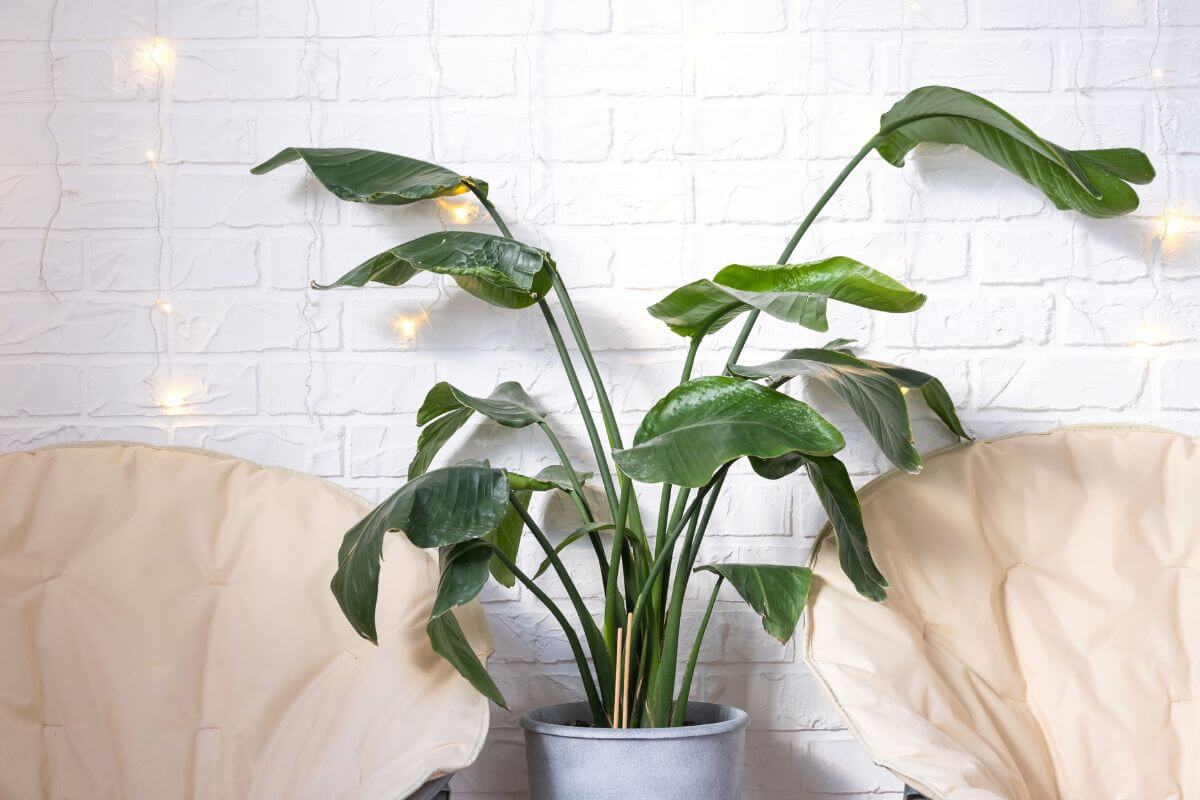
The White Bird of Paradise loves warm, tropical weather. To make sure it stays happy, you need to get the temperature just right. This plant does best in temperatures between 65°F and 80°F (18°C to 27°C) during the day. At night, it likes it a bit cooler, around 60°F to 65°F (15°C to 18°C).
Here are some easy-to-follow tips to keep your White Bird of Paradise healthy:
- Daytime – Keep it between 65°F and 80°F (18°C to 27°C).
- Nighttime – A bit cooler, around 60°F to 65°F (15°C to 18°C).
Don’t let it get too cold (below 50°F or 10°C) or too hot (above 90°F or 32°C). Extreme temperatures can make the plant very unhappy, leading to discolored or dead leaves.
If you see your plant looking sad, check the temperature first. Adjust it to the right range, and your White Bird of Paradise should perk up.
Pruning the White Bird of Paradise
Pruning is generally not necessary for the White Bird of Paradise except to remove dried-out, damaged, yellowing, or dying foliage.
The plant’s large leaves can get damaged by strong winds, making the plant look messy. To stop this, put it in a spot where it is protected from strong winds.
Propagating the White Bird of Paradise
While the White Bird of Paradise can be propagated by seeds, the easiest method is to divide the plant’s rhizomes at the start of spring.
If you choose to use seeds, know that this method is very slow. Propagation can be accomplished more easily through rootball division.
However, with root division, the plant requires more time to rebound and regain its attractive appearance.
- Read more about Propagation Tips for Bird of Paradise
White Bird of Paradise Problems — Toxicity, Leaf Curling, and Pests
The White Bird of Paradise is considered to be toxic to humans and pets if ingested. Avoid placing them in areas that your pets and small children can get to.
Should your plant exhibit dry leaves or crispy leaf tips and edges, it is likely underwatered. The same is true if foliage curls, splits, breaks, or withers.
- Read more about Bird of Paradise Leaf Curl Solutions
It is resistant to most common diseases and pests with a few exceptions. Root rot is a risk for the White Bird of Paradise and is almost always caused by overwatering or insufficient drainage. Make sure the pot used when cultivated as a houseplant has a good number of drainage holes.
Common house pests to be on the lookout for include:
- Spider Mites – Cause small white flecks on the leaves of white birds of paradise plants by sucking the plant sap, eventually leading to leaf bronzing and premature leaf drop.
- Mealybugs – Excrete honeydew on the plant, leading to sooty mold growth, yellowing leaves, dieback, and stunted growth.
- Aphids – Suck sap from white bird of paradise plants, causing stunted growth, yellowing leaves, and honeydew excretion that promotes sooty mold.
- Scale Insects – Both soft and armored types damage the plant by sucking plant sap, leading to stunted growth and potential death of the plant when infestations are heavy.
- Whiteflies – Suck juices from plant’s leaves, causing premature yellowing and leaf drop, while also excreting honeydew that attracts sooty mold.
These pests may arrive from other houseplants with infestations. Mealybugs and scales can be removed manually. Aphids can be washed off with jet sprays of water.
In any case, treat your plant with insecticidal soap or organic neem oil if you see any pests appear.
Great Companion Plants for White Bird of Paradise
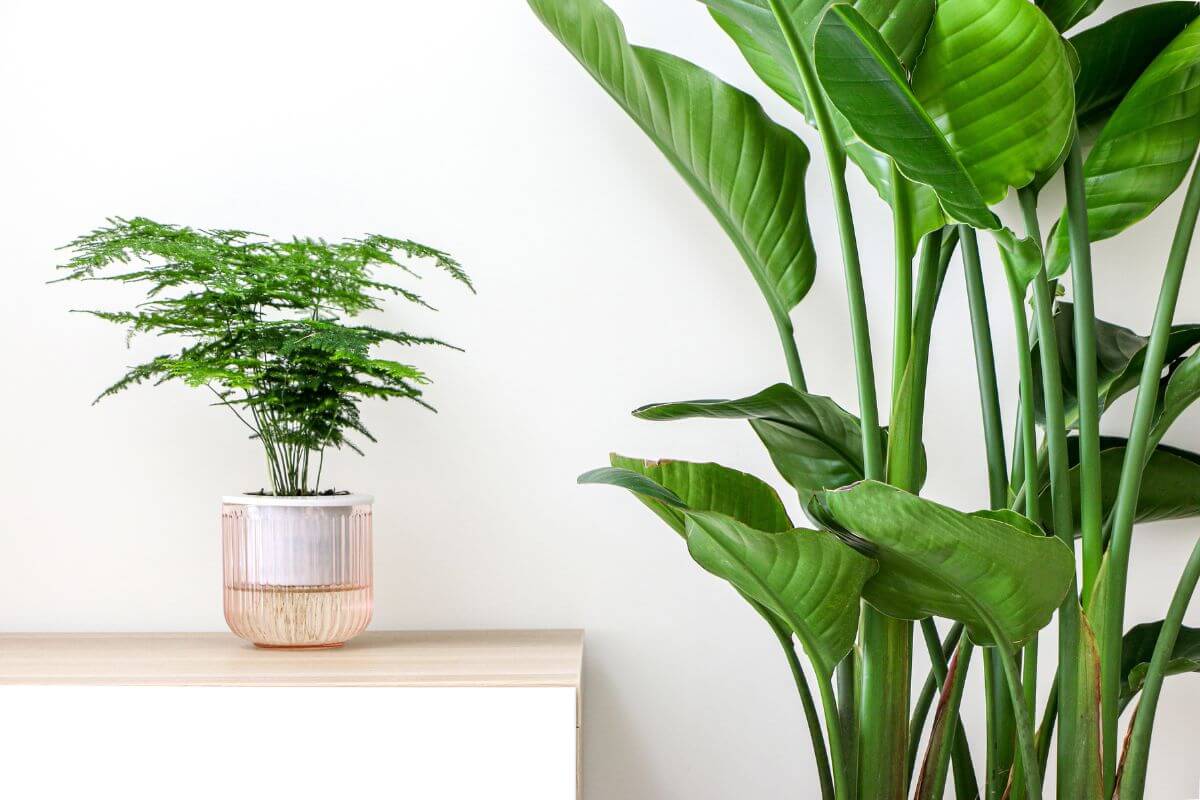
Companion plants can give white bird of paradise plants beneficial things. They provide shade, humidity, and pest control. These also help the bird of paradise thrive indoors.
Here are some plants that go well with White Bird of Paradise:
- Asparagus Fern (Asparagus setaceus) – It is a good companion for White Bird of Paradise plants. It has a texture that complements them and can thrive in their light and moisture conditions.
- Leatherpetal (Graptopetalum) – Leatherpetal enhances soil fertility. It also provides ground cover, which benefits the white bird of paradise.
- Yellow Elder (Tecoma stans) – Bright yellow trumpet flowers stand out against the White Bird of Paradise’s foliage.
- Areca Palm (Dypsis lutescens) – Feathery fronds add texture and contrast to the White Bird of Paradise.
- Downy Jasmine (Jasminum multiflorum) – Trails nicely around the base of the White Bird of Paradise.
- Blue Chalksticks (Senecio mandraliscae) – It has blue-green foliage. The cool tones of the foliage complement the white bird’s warmth.
White Bird of Paradise Final Thoughts
The White Bird of Paradise earns its fame for its large size. It has banana-like leaves and beautiful bird-shaped flowers. It doesn’t matter if you want to make this an outdoor or an indoor plant, this gorgeous plant will always stand out.
Give it lots of sun and use well-draining soil. This is best for growth and to avoid dryness or root problems. Fertilize it occasionally while it grows to keep it healthy and vibrant.
It usually doesn’t have many pest or disease issues. But, check for things like spider mites or aphids sometimes. And remember, it’s toxic if eaten, so keep it away from pets and kids.
Caring for a White Bird of Paradise adds tropical beauty to any space. You earn lush leaves and occasional blooms with your efforts.
White Bird of Paradise FAQs
1. Where Do You Put the White Bird of Paradise?
Ideally, it is best to place your white Bird of Paradise where it can at least 6 hours of direct sunlight. If you’re growing it indoors, you’ll want to position your pot by a south-facing window.
2. Is the White Bird of Paradise Rare?
Yes, the White Bird of Paradise is quite rare. It is the rarest of the three banana-like Strelitzia varieties, making it an exotic houseplant.
3. What Does the White Bird of Paradise Mean?
Birds of Paradise plants generally symbolize freedom. In particular, the White Bird of Paradise represents purity and spiritual enlightenment.
Here are other Bird of Paradise articles to check out:

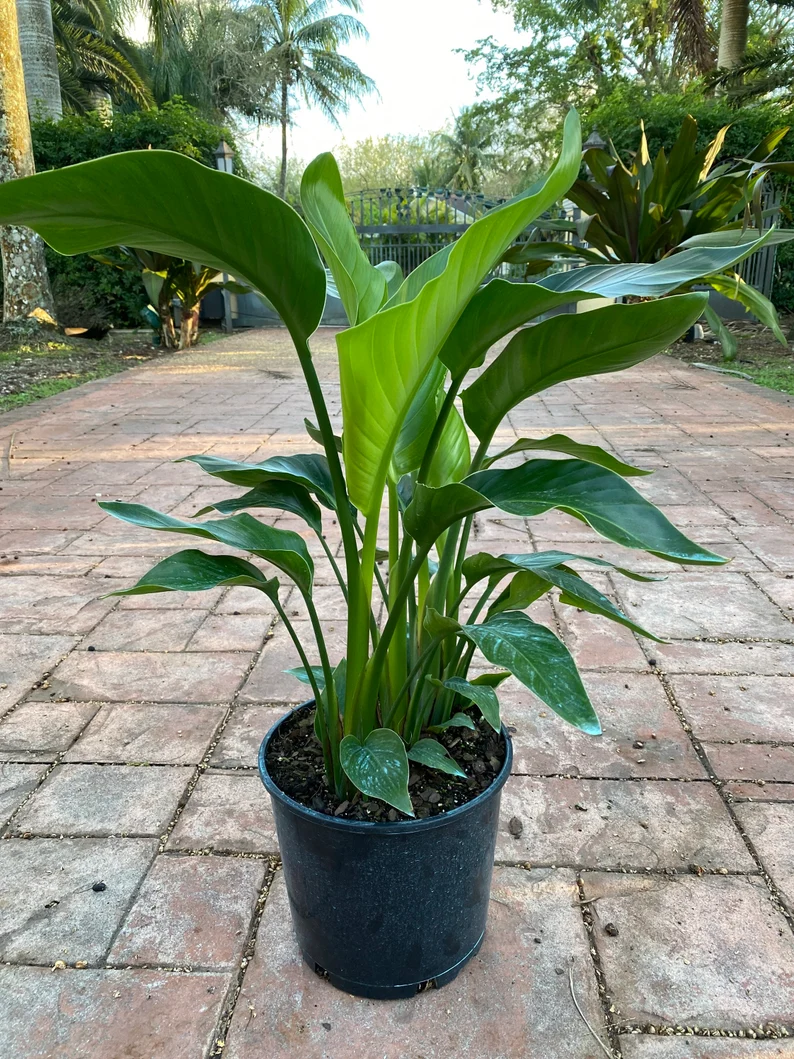



I live in the panhandle of Florida and we got frost. My Bird of Paradise didn’t do well. The frost got to it. So how do I prune it to save it? If at all possible. Thank you